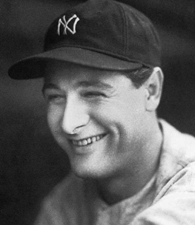Lou Gehrig anchored the Yankees’ “Bronx Bomber” teams of the 1920s, playing in a record-setting 2,130 consecutive games over 14 seasons. His career would be cut short when he was diagnosed with amyotrophic lateral sclerosis, an incurable neurodegenerative disease that would become known as “Lou Gehrig’s disease.” In a goodbye speech to the Yankee Stadium crowd, he declared himself “the luckiest man on the face of the Earth.”
Lou Gehrig’s Early Days
Henry Louis Gehrig was born on June 19, 1903, in the Yorkville section of Manhattan. He excelled both academically and athletically, and was a star player on the football and baseball teams at Columbia University.
Gehrig famously hit many home runs out of Columbia’s South Field, including one off the university library’s steps. In 1923, New York Yankee scout Paul Krichell convinced Gehrig to leave Columbia after his sophomore year and sign for the Yankees.
Sources in this Story
- Columbia University: Living Legacies: Lou Gehrig: Columbia Legend and American Hero
- Lou Gehrig: The Official Web Site: Biography
- MLB.com: Gehrig’s shining legacy of courage
- Baseball Reference: Lou Gehrig
- findingDulcinea: On This Day: Lou Gehrig Delivers “Luckiest Man” Speech
- Lou Gehrig: The Official Site: Farewell to Baseball Speech
- National Baseball Hall of Fame & Museum: Lou Gehrig
- ESPN: Outside the Lines: Letters of Lou
- Time: In Memoriam
Gehrig’s Baseball Career
After spending two years bouncing between the Yankees and their minor league affiliate in Hartford, Gehrig joined the Yankees for good in 1925. On June 2, 1925, a day after pinch-hitting, he replaced first baseman Wally Pipp in the starting line-up (the legend that Pipp pulled himself out of the line-up with a headache is untrue). He would play in 2,130 consecutive games over the next 14 seasons.
In 1927, he hit .373 with 47 homers and 175 RBIs, winning the MVP award and helping the ’27 Yankees—regarded as one of the greatest teams ever—to a World Series championship. He and Babe Ruth dominated the game, finishing 1–2 in home runs for five straight years and sometimes out-homering entire teams. Gehrig was often overshadowed by Ruth’s larger-than-life personality, but he didn’t mind: “It’s a pretty big shadow. It gives me lots of room to spread myself,” he said.
In 1934, Ruth’s final year, Gehrig won the Triple Crown. Two years later, he would be joined by Joe DiMaggio, beginning a stretch of four straight World Series titles. Gehrig, however, would not play in the last of the four.
On May 2, 1939, feeling weak and sluggish, Gehrig removed himself from the lineup. A month later, he would be diagnosed with amyotrophic lateral sclerosis, an incurable disease. He would never play again.
Gehrig finished his career with a .340 lifetime batting average, with 493 homers and 1,995 RBIs. Despite his shortened career, he ranks 25th all-time in homers, fifth in RBIs and third in slugging and OPS.
The Man and His Work
- “Iron Horse: Lou Gehrig in His Time,” by Ray Robinson
- “Luckiest Man: The Life and Death of Lou Gehrig,” by Jonathan Eig
Gehrig’s Battle With ALS
On July 4, 1939, the Yankees held “Lou Gehrig Appreciation Day,” in which he became the first player in the major leagues to have his number retired. Between games of a double-header, former teammates and dignitaries honored Gehrig with speeches and gifts.
Gehrig then addressed the crowd: “For the past two weeks you have been reading about a bad break. Yet today I consider myself the luckiest man on the face of the earth…So I close in saying that I may have had a tough break, but I have an awful lot to live for.”
Gehrig remained with the team to carry out the lineup card for the remainder of the Yankees’ World Series-winning season. After the season, he was elected to the Baseball Hall of Fame.
New York Mayor Fiorello La Guardia offered him the job of New York City parole commissioner. Gehrig served a year and a half before his physical condition became too poor to continue.
In letters between Gehrig and his doctor at the Mayo Clinic which were released publicly in 2009, it is revealed that Gehrig was unaware of the true severity of his disease. He held out hope for recovery, though, as his condition worsened, he began to accept his fate.
“I intend to hold on as long as possible and then if the inevitable comes, I will accept it philosophically and hope for the best,” he wrote on January 13, 1941. “That’s all we can do.”
On June 2, 1941, Lou Gehrig died in his Bronx home. Flags were flown at half-staff in New York and ballparks across the country.
Sportswriter Westbrook Pegler wrote in the New York World-Telegram, “The Lou Gehrigs should not be rare. They should be the standard human type, for, after all, Lou was a simple soul, with no affectations, who didn’t have to work at being good and kind…That was what it was that made Gehrig great above and beyond his size and achievements, and it is no credit to the breed that so many of us are so unlike this fine man that we must stand in such awe of his simple virtues.”
This article was originally written by Denis Cummings; it was updated May 22, 2017.











